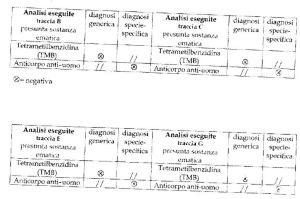In the G.U.P hearing (04.10.2008) and in the Court of Assizes (hearing on 23.05.2009), Dr. Stefanoni explained that no traces visible to the naked eye were present on the knife under examination, and that the samples were taken from parts of the [knife] where, based on her own experience, it might have been possible to find biological material. (G.U.P hearing on 04.10.08, pages 17-18: “with regard to sample A, nothing was visible; however, our experience and common sense led us to collect [a sample] there…the [location] of sample B was not just chance…the sample was taken at that point because, again only from a visual inspection, that is, with no instrument…streaks were visible to the naked eye”. Court of Assizes (record of the 23.05.09 hearing, page 81): “these scratches were the only element which could, so to speak, guide me in a sample which otherwise was completely random, as happened subsequently; the other samples which were taken from the knife, therefore I’m referring to…also to C, which in fact was sampled at the same time as A and B, but also in particular those which followed, E and G, were done more or less in a random manner because there was no fact, no element which would have led me to take a sample at this point, say, rather than another”.
Court of Assizes (record of the hearing on 23.05.09), page 94): “sample B was taken at this point on the basis that no significant biological trace was visible, so to speak, to the naked eye. [Sample] A was taken at that point, naturally on the handle, as also with D and F, with the intention of possibly finding DNA from the person who had handled that weapon [arma]”.
It is not explicitly indicated in the report whether the environment where the sampling was carried out (particularly the work bench surfaces as well as all the equipment present) was preemptively decontaminated with suitable substances (e.g. sodium hypochlorite or similar), whether sterilized instruments were used, and the method by which these were sterilized. With regard to the samples taken from the exhibit, it is not specified whether these were performed using sterile swabs, with changes of gloves for each individual sample, and with the wearing of lab coats and masks by the operatives.
On page 77 of the Technical Report on the Forensic Genetic Tests (RTIGF) four photos are shown of the exhibit, bearing letters from A to G on the handle and the blade, which are indicative of the points from which the samples of presumed biological material were taken.
In particular, it is apparent that three samples were taken from the handle of the knife (samples indicated with the letters A-D-F) and four samples from the blade (samples indicated with the letters B-C-E-G) for a total of seven samples.
The Work Status Report cards (SAL) show that each individual sample was given an identification code (Sample ID Code), reported below:
Sample A (“presumed exfoliated cells, letter A”) = 47329
Sample B (“presumed haematic substance, letter B”) = 47330
Sample C (“presumed haematic trace, letter C”) = 47331
Sample D (“presumed exfoliated cells, letter D”) = 48649
Sample E (“presumed haematic substance, letter E”) = 48651
Sample F (“presumed exfoliated cells, letter F”) = 48654
Sample G (“presumed haematic substance, letter G”) = 48655
In addition, the following information is reported (c.f. SAL): Type of Sample, Sample Description, Quantity extracted, Location extracted, Test Performed, Date of extraction.
The SAL shows that the generic test for blood was performed on the samples indicated with the letters B-C-E-G (samples taken from the knife blade), using the tetramethylbenzidine test (TMB).
The aforementioned method, widely recognized in forensics, is numbered amongst the preliminary methods for the identification of blood; if positive, further tests (known as ‘confirmatory’) are needed in order to correctly identify blood.
The summary tables of the tests carried out on the samples and the results obtained are reproduced below, as shown on pages 77-78 of the RTIGF:
From the above tables, it is clear that the blood tests carried out on the samples indicated by the letters B-C-E-G (knife blade) were negative for the presence of blood.
The “species-specific” test was performed on the aforementioned samples, and also tested negative for the human species.
Conversely, the tetramethylbenzidine test was not performed on the samples indicated by the letters A-D-F (samples taken from the knife handle).
It must be emphasized that no laboratory tests were performed to detect biological material of a non-haematic nature on any of the samples analyzed.
It is considered that it would have been necessary to proceed to morphological tests to identify cells which might have been present, by means of colouration with one of the reagents commonly employed in histology (hematoxylin). Such a test, quick and easy to carry out, would have required a minimum quantity of material and would not in any way have compromised further laboratory testing, but could have clarified the nature of the material removed from the item under examination.
Despite the negative result of the blood identification test and the failure to carry out cell identification tests (and therefore the failure to identify the material removed from Exhibit 36) the Technical Consultant hypothesized the presence of “presumed exfoliated cells” on the material sampled from the knife handle (traces A-D-F) and of “presumed biological material” of another nature (presumably blood, considering the tests aimed at the detection of haematic peroxidases) on the material sampled from the blade (samples B-C-E-G).
The hypotheses formulated by the Technical Consultant about the nature of the material analyzed are wholly arbitrary in that they are not supported by any scientifically objective confirmation.
Next: Extraction of DNA

Leave a comment